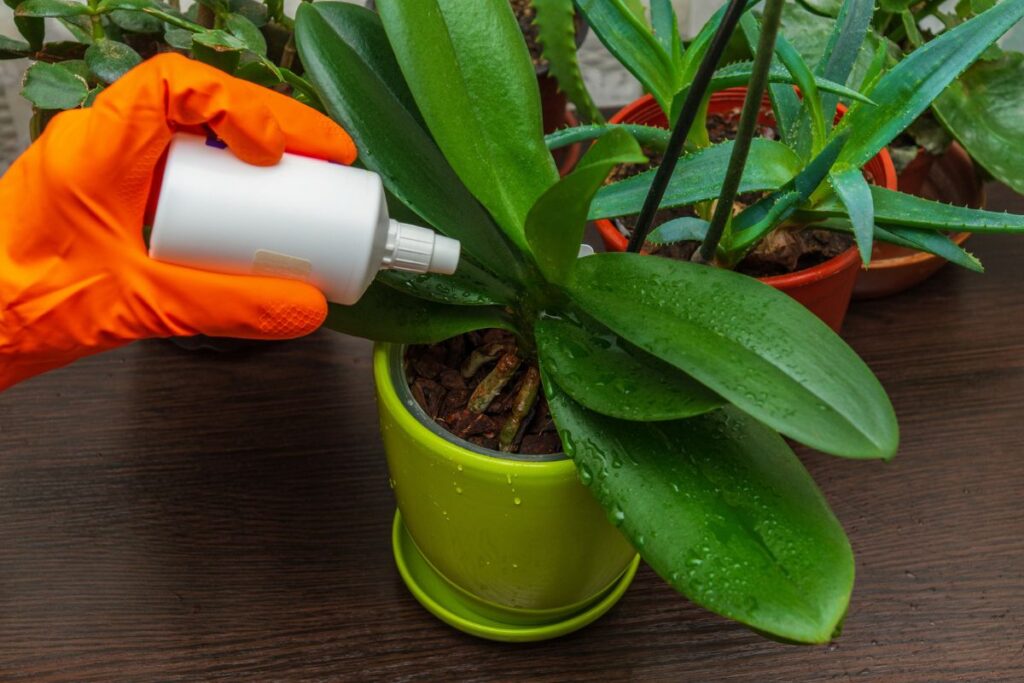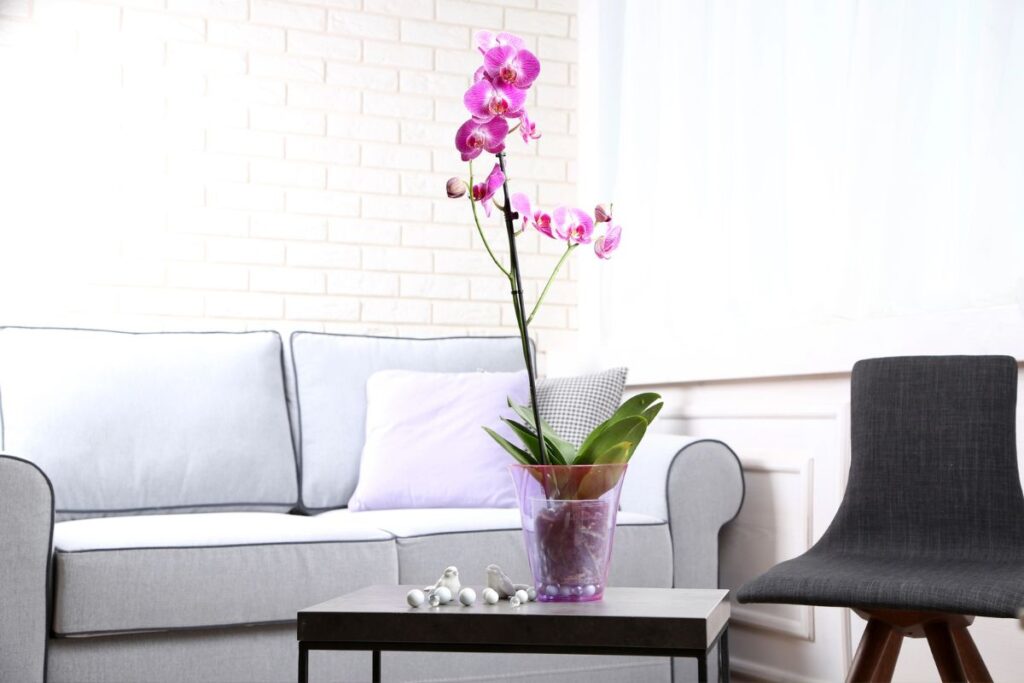Is your orchid refusing to bloom?
Don’t worry, you’re not alone.
There are common reasons behind this issue—and simple solutions!
Discover the top 10 reasons your orchid isn’t flowering and how to fix them.
Ready to help your orchid thrive?
Let’s get started!
Understanding Orchid Non-Blooming Issues and Remedies

1. Temperature Issues
Your orchid’s failure to bloom could be due to improper temperature settings.
Orchids flourish under specific day and night temperatures, favoring gentle warmth during the day with a slight dip at night.
Optimal day temperatures for many orchids range between 66-75°F and should decrease by about 5°F at night.
To encourage blooming, adjust your thermostat to maintain around 55-66°F at night.
A cooler evening temperature, lower by approximately 10°F from the day, for about a month can stimulate the production of healthy flower spikes.
To prevent temperature shock, avoid placing your orchids near drafty windows, air conditioning units, or heaters where sudden temperature fluctuations are common.
2. Insufficient Light
Orchids that don’t receive enough light often fail to bloom since light is crucial for photosynthesis, the process by which plants produce food to support flowering.
If your orchid is tucked away in a dimly lit area, consider moving it to a brighter location.
While Cymbidium and Cattleya orchids can tolerate brighter light, Phalaenopsis (moth orchids) do best with diffused, indirect sunlight found near east-facing windows.
When transitioning your orchid to more light, do it gradually to avoid stress. A few hours of additional light each day over the course of a week should suffice to acclimate your plant.
3. Excessive Light

Conversely, too much light can be equally detrimental, potentially scorching the leaves and disrupting flowering.
If placed in direct sunlight, especially from a west-facing window, consider using a sheer curtain to diffuse the light or relocate your orchid to a spot with gentler morning sunlight.
When using artificial grow lights, keep them at least a foot away from the orchid and set a timer to ensure your plant receives a balanced cycle of 12-16 hours of light and darkness.
4. Old Flower Spikes
Once an orchid spike has finished blooming and begins to yellow or brown, it’s important to prune it.
Cut back spent spikes at the base to make room for new growth. If the spike remains green without blooming, trim just above a node to potentially stimulate new flowers.
Maintain cooler night temperatures during this process to encourage growth of new spikes.
5. Repotting Needs

The structure of your orchid’s potting mix is essential for root health, but it can break down over time.
Repotting is necessary when roots are growing out of the pot or the existing mix has deteriorated.
Choose a container 1-2 sizes larger with appropriate drainage and ventilation.
After repotting, water thoroughly and avoid compacting the new potting medium to ensure healthy root development.
6. Fertilizer Deficiency

A lack of nutrients can also affect an orchid’s ability to bloom. Regular feeding with an orchid-appropriate fertilizer can provide the essential nutrients needed for flowering.
Follow the instructions on the fertilizer’s packaging for the correct dosage and frequency to avoid over or underfeeding, which can harm the plant.
7. The Problem of Underwatering
Water is vital for orchids, but they require a delicate balance. Underwatering can lead to dehydration, causing the plant to reserve resources and inhibit blooming.
Ensure your orchid receives consistent, adequate moisture—typically when the top inch of the potting medium feels dry to the touch.
8. Overwatering and Root Rot in Orchids

Overwatering, on the other hand, can lead to root rot, a severe condition that prevents nutrient absorption and can be fatal.
To avoid this, water only when necessary and ensure your pot has good drainage to prevent excess water from sitting around the roots.
9. Importance of Humidity for Orchid Flowering
Orchids prefer a humid environment, and low moisture levels can prevent them from blooming.
Aim to maintain a humidity level around 40-60% for optimal orchid health.
You can achieve this by placing a humidity tray filled with water and pebbles underneath the plant or using a room humidifier.
10. Rest Period Requirement for Orchids
Lastly, orchids need a rest period to gather energy for the next blooming cycle. This is a natural phase often occurring after flowering, where the plant grows new leaves and roots.
You can assist by reducing watering and stopping fertilizer application during this time to mimic the orchid’s natural habitat conditions.
By understanding these common orchid care issues, you can take the steps to correct them and enjoy the vibrant blooms that these exotic plants are known for.
With consistent care and attention to their unique needs, your orchids can thrive and flower beautifully.
Orchid Rebloom Essentials

Enhancing your interior space with orchids can add a touch of elegance. To ensure those orchids flourish with vibrant flowers once more, consider these carefully curated strategies:
- Nightly Temperature Drop: Aim to decrease the night-time temperature by approximately 10°F to signal the orchid it’s the right time to bloom.
- Indirect Sunlight Exposure: Position your orchid where it can bask in abundant indirect sunlight, avoiding direct rays that may harm it.
- Watering Wisdom: Hydrate the plant when the roots adopt a silver-green hue, an indicator the orchid is ready for moisture.
- Regular Fertilization: Nourish your orchid weekly with a diluted houseplant feed at a quarter of its normal strength, or adhere to the guidelines of specialized orchid fertilizers.
- Humidity Control: Orchids thrive in conditions with 40-70% humidity, so maintain an environment within this range for optimal health.
- Timely Repotting: Once roots peek through the drainage holes or you spot any that are deteriorating, it’s time to repot.
- Prune for Health: Snip off old, discolored flower spikes to encourage new growth and maintain the plant’s vigor.
- Respecting Dormancy: Give your orchid its well-deserved rest period without disturbances to set the stage for the next blooming cycle.
Frequency of Orchid Blooming

Varieties That May Re-bloom Within a Year
Orchids, with their stunning array of colors and long-lasting blooms, are a captivating addition to any space.
On average, these plants grace us with their flowers annually. A Phalaenopsis orchid, for example, will bloom once every year, generously offering its stunning flowers for up to four months.
While less enduring, Cattleya and Cymbidium orchids provide a shorter but equally magnificent display, with their bloom periods lasting from a few weeks to around three months, respectively.
Certain orchids, however, can surprise you by flowering multiple times within the same calendar year.
The Vanda orchids, should they bask in abundant light, are equipped to produce blossoms up to three times annually.
In contrast, some Dendrobium orchids can potentially present flowers four to five times within the same span, given optimal conditions such as a significant potassium boost, a chilly winter ambiance around 55°F, and a modest reduction in watering.
An intriguing case is the Oncidium orchid, defying typical flowering patterns by blossoming one to two times a year based solely on the maturity of its stems rather than the season.
| Orchid Type | Bloom Frequency | Notes |
|---|---|---|
| Vanda | Up to 3 times a year | Requires intense light |
| Dendrobium | 4-5 times a year (potential) | Needs higher potassium, cool temps |
| Oncidium | 1-2 times a year, stem-based | Stems maturity dictates blooming |
By ensuring your orchids receive the care attuned to their specific needs, you may be rewarded with several blooming cycles, multiplying the joy these remarkable plants bring into your life.
Enhanced Orchid Maintenance Tips
Cultivating orchids in Lightweight Expanded Clay Aggregate (LECA) pebbles is a remarkable method to sidestep overwatering and avert root decay.
It’s a straightforward process: layer your pot with LECA pebbles, situate your orchid, and top off with more pebbles before dousing them in water.
The clay pebbles promise vigorous airflow and unmatched simplicity—merely top off the water as it evaporates and introduce hydroponic fertilizer to supply vital nutrients promoting the orchid’s prosperity.
Prefer a more traditional medium? Consider utilizing mixes based on peat or bark which also facilitate healthy orchid growth.
Pruning isn’t a routine necessity, yet it could prompt a robust blooming phase. Once your orchid appears robust, clip the stem a tad above the dormant buds, colloquially known as “eyes,” to encourage new spikes.
This cut should be about half an inch to ensure the best possible regrowth.
Post-pruning, should roots become conspicuous, consider transplanting the orchid to a container slightly larger than the existing one. This helps circumvent excessive moisture retention, which can be detrimental.
Subsequent care entails watering when the growing medium dries, positioning your orchid to bask in the gentle light of an east or south-facing window, and providing nutrients through regular feeding.
Optimal Orchid Selection for Home Interiors
When selecting an orchid for your home, the Phalaenopsis orchid emerges as a prime candidate.
Not only does it offer a yearly bloom that lasts for an extended period, often several months, but it also thrives with minimal effort.
This particular orchid, commonly known as the Moth orchid, coexists harmoniously with plants such as African violets.
If you’re looking for another variety that rivals the Phalaenopsis in terms of ease of care and long-lasting flowers, consider the Paphiopedilum orchid. Like its counterpart, it blooms annually with the flowers persisting for many months.
For those desiring more frequent flowering periods, the Vanda or Dendrobium orchids are ideal, as they’re known to blossom multiple times throughout the year.
Final Thoughts
Armed with a clear understanding of how to foster reblooming, you are well-equipped to nurture your orchids back into their vibrant state. Keep these insights in mind to encourage a flourish of blossoms:
- Addressing non-flowering: Swiftly tackle the common reasons behind your orchid’s reluctance to bloom to see a turnaround.
- Nurturing techniques: Implement the shared tips and practices to entice your orchid into blooming once more.
- Varietal flowering durations: Recognize that different orchid species have varying bloom periods ranging from fleeting to lasting.
- Indoor orchid selection: Choose an orchid that aligns with your desire for either long-lasting flowers or frequent blooming cycles.
Putting these strategies into action should lead to a rewarding display of flowers. Happy gardening until our paths cross again!
Feel moved by these insights? Consider spreading the word or bookmarking this page!

